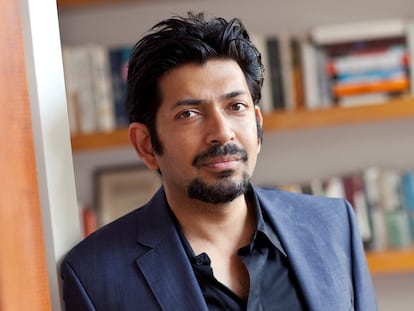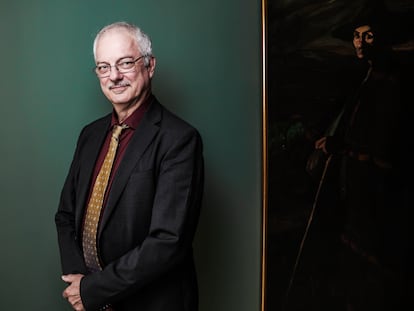‘It’s incredible that in 2023, there are only six female CEOs of biotech companies’
Yvonne Greenstreet, CEO of Alnylam Pharmaceuticals, believes we are facing a new generation of drugs that will write ‘new chapters in medicine textbooks’

Yvonne Greenstreet (London, 61 years old), the daughter of a British man and a Ghanaian, spent her childhood in her mother’s country. There she discovered her vocation for medicine. She soon moved on to the world of the pharmaceutical industry, where she is today the President and CEO of Alnylam Pharmaceuticals, a company based in the U.S. that works on researching medicines based on a technology platform called RNA interference, a very different approach from what is normally used to discover new drugs.
Question. You grew up in Ghana. Did you develop your vocation for medicine there?
Answer. That was one of my motivations for wanting to do medicine, because when you grow up in a developing country, you see very directly the impact of adverse medical outcomes. From a very young age, I wanted to help patients and I wanted to be in healthcare. So I trained as a physician, but I also wanted to be able to impact global problems, and therefore I decided to go to INSEAD in France. I did an MBA there, and after that I joined the biopharmaceutical industry because I really believed that as a clinician I had the opportunity to help 100 patients, maybe a thousand patients.
Q. The vast majority of drug company leaders are white men. Do you think it has been more difficult for you to get where you are?
A. I am in the very fortunate position to be leading what I believe is the most exciting biotech company in the industry. It’s an incredible honor and privilege to be doing that. Clearly it’s been a long journey for me. I’ve been in the biopharmaceutical industry for nearly three decades now. In that time, I’ve been able to experience many different parts of the business to allow me to have a holistic view of how we can grow this company and how we can impact patients as profoundly as we can. Yes, there have been challenges along the way, but I think it’s really important that we have more and more leaders in the industry that are female or people from less traditional backgrounds. It’s actually incredible to me that in 2023, if we look across biopharma companies, that the only six female CEOs of biotech companies that have market capitalizations more than 5 billion. So we have a lot of work to do.
Q. Tell me about the technology your company uses: RNA interference.
A. The technique is based on Nobel Prize winning science. What the technology is able to do is basically silence the genetic expression of proteins, so we can knock down abnormal disease-causing proteins in the body.
Q. And what do medicines based on this technology do in the body?
A. What we’re able to do is target the drugs to specific tissues in the body. The tissue where we have the most experience is the liver. Essentially, we’re able to administer an injection and, within the liver, knock down specific target genes that are disease-causing. The most exciting and next tissue that we’ve been able to address is the central nervous system. So we’ve now been able to demonstrate that we can get the medicine into the CNS and knock down targets of interest in the CNS. And therefore we can think about addressing diseases like Alzheimer’s, Parkinson’s, and ALS.
Q. Are you far from those goals?
A. Just a few months ago, hot off the press, we were able to demonstrate the first human translation of this technology in the clinical setting. So we were able to demonstrate that we were able to knock down a protein called amyloid precursor protein, which is the starting point of the amyloid cascade, which results in Alzheimer’s. And we tested this in patients with early onset Alzheimer’s disease. We were able to show that we were able to robustly, durably, for an extended period of time, knock down amyloid precursor protein as measured by specific markers in the CSF. There are some ways to go, but this is a really groundbreaking achievement.
Q. Now your focus is on rare diseases.
A. We started testing the technology in rare diseases, because those are diseases where the patients have very few therapeutic alternatives. They have nowhere to go. We were able to identify specific genes that our technology could address and therefore impact a number of different rare diseases. We now have four RNA therapeutics that are available for patients around the world. Our innovation has resulted in four RNA only therapeutics in less than five years. That is a remarkable achievement for any company.
Q. How many patients are being treated with these medications?
A. Right now, across the globe, we’re treating about 3,599 patients. But as we go into these more common diseases, we will be able to treat millions of patients around the world. To give you one example, we have a very exciting opportunity in our pipeline for hypertension. Hypertension is the most important preventable cause of cardiovascular morbidity and mortality. The issue is that whilst there are a number of medicines to treat hypertension, compliance is very poor and patients experience poor outcomes from currently available therapeutics. What our technology can do is through a little subcutaneous injection, given maybe once a quarter or once every six months, we can knock down a relevant protein for hypertension called angiotensin. This results in what we call tonic control. So you don’t get the ups and downs that you get with other medications. You don’t have the compliance issues because the patients have injections on an infrequent basis. We believe that this technology has the opportunity to reimagine how hypertension is treated.
Q. What about the side effects?
A. Right now the safety looks very encouraging. We are still in the early stages of testing the medicine. And over the next few years, we’ll be testing the medicine in thousands of patients.
Q. Do you think that with technologies like this and the messenger RNA that became popular with vaccines, we are facing a new stage in medicine?
A. We’re in an era of incredible biomedical innovation, and we are at the forefront of that. We are going to be able to address tens or twenties of different types of diseases over the next period of time. We are going to be able to write new chapters in textbooks of medicine.
Q. In 10 years, will the panorama of medicine be very different from the current one, much more than today compared to a decade ago?
A. Absolutely. If we just imagine what we have in the pipeline right now, we have four therapeutics that are actually treating patients today. We have over ten clinical programs in our pipeline. We have another program for diabetes. So we’re on the cusp of being able to provide a whole new generation of medicines. And I think what is very unusual about a company like Alnylam is the opportunity to build a company around medicines that are already being used by patients. In addition to having this very rich clinical pipeline with many programs across rare diseases, more prevalent diseases, liver diseases, as well as central nervous system diseases. This is all supported by a scientific platform that we believe will be able to generate for three to four new opportunities every year.
Q. Is it easier to find new drugs with this technology than discovering new molecules?
A. Yes. The hard part is improving the platform. It took about 18 years from the founding of the company to providing patients with the first drug. But, since then, we have created four therapies in less than five years.
Q. Are you concerned about whether these high-tech drugs are affordable?
A. I believe that innovation has an opportunity to impact health equity. Going back to the example I gave you of the drug that we’re developing for hypertension, the main issue that people have with hypertension, strokes and heart attacks is because they don’t see their doctors, and they don’t take their medicines. We can provide a vaccine-like strategy to some of these chronic diseases, and I believe that in the future we will be able to address these sorts of issues on a global level. We can address the needs of underserved populations, because you don’t need to be seeing a doctor every week or every month to remember to take your medicines. You can just have a vaccine to help manage these diseases. So I think innovation provides the opportunity to change health outcomes for all sorts of people.
[But] innovation is very expensive. Alnylam has raised $7 billion over the course of its journey, and we’re not yet profitable. So it’s a very high risk, capital-intensive business. We will not be able to continue to invest in this technology and provide new medicines for new diseases for new generations unless we are able to have the revenues that allow us to do this, so we need to change the dialog that we have with society. There is an understanding that to benefit from innovation, there will need to be investment to drive that innovation. But then over time that innovation becomes older, and it becomes less expensive as drugs become generics.
Sign up for our weekly newsletter to get more English-language news coverage from EL PAÍS USA Edition
Tu suscripción se está usando en otro dispositivo
¿Quieres añadir otro usuario a tu suscripción?
Si continúas leyendo en este dispositivo, no se podrá leer en el otro.
FlechaTu suscripción se está usando en otro dispositivo y solo puedes acceder a EL PAÍS desde un dispositivo a la vez.
Si quieres compartir tu cuenta, cambia tu suscripción a la modalidad Premium, así podrás añadir otro usuario. Cada uno accederá con su propia cuenta de email, lo que os permitirá personalizar vuestra experiencia en EL PAÍS.
¿Tienes una suscripción de empresa? Accede aquí para contratar más cuentas.
En el caso de no saber quién está usando tu cuenta, te recomendamos cambiar tu contraseña aquí.
Si decides continuar compartiendo tu cuenta, este mensaje se mostrará en tu dispositivo y en el de la otra persona que está usando tu cuenta de forma indefinida, afectando a tu experiencia de lectura. Puedes consultar aquí los términos y condiciones de la suscripción digital.
More information
Archived In
Últimas noticias
Most viewed
- Sinaloa Cartel war is taking its toll on Los Chapitos
- Oona Chaplin: ‘I told James Cameron that I was living in a treehouse and starting a permaculture project with a friend’
- Reinhard Genzel, Nobel laureate in physics: ‘One-minute videos will never give you the truth’
- Why the price of coffee has skyrocketed: from Brazilian plantations to specialty coffee houses
- Silver prices are going crazy: This is what’s fueling the rally











































